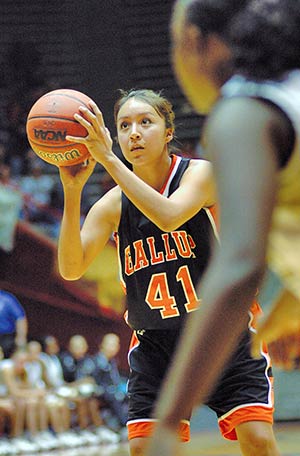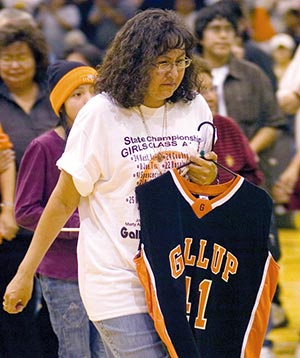Memory wall tells cost of domestic violence
By Bill Donovan
Special to the Times
GALLUP, June 17, 2011


(Special to the Times - Donovan Quintero)
TOP: The late Brooke Spencer (41) shoots against a Hobbs defender during the Class 5A quarterfinals in March 2006 at the UNM Pit in Albuquerque. Gallup defeated Hobbs, 49-34.
BOTTOM: LeAnn Eskeet Spencer, the mother of the late Gallup Lady Bengals basketball player Brooke Spencer, carries her daughter's traveling jersey at a ceremony to permanently retire No. 41 in December of 2006.
The 4th Annual Brooke Spencer Memorial Tournament will be held Friday and Saturday, June 17-18, at Gallup High with high school students from throughout this area competing.
But LeAnn Eskeets, Brooke's mother, hopes that young people, in particular, who come to enjoy the tournament will take some time and think about reason for its existence.
Her dazzling daughter seemed the least likely victim of domestic violence, but that's what killed her. Spencer, 18, was stabbed to death by her 19-year-old ex-boyfriend, Phillip Notah. Eskeets wants other young people to think about the misery that domestic violence is causing in this area.
"We plan to have speeches on domestic violence between the games," Eskeets said, "and we will also have a memory wall set up to allow families to place photos and stories of others who have died in this area because of domestic violence."
Notah confessed to stabbing Spencer, who had broken off their relationship and had her sights set on college. He is scheduled for release from prison in 2019, a prospect that upsets her mother.
"Once he gets out, he will be able to continue his life," Eskeets said. "He will be able to get married, have children and have a full career, something my daughter will never be able to do."
She is part of a community of people who still carry the scars from losing someone close because of domestic violence, a crime that continues to grow not only in Gallup but throughout the Navajo Nation.
For the past five years, Eskeets has been talking to local teenagers about the dangers of getting into a relationship with someone who may become violent. She also has a message for parents to watch over their children and to recognize signs of possible domestic violence in their children's relationships with other people.
"What happened with Brooke can happen to anyone," Eskeets said, adding that she was just as clueless as many parents are today before the tragedy and didn't pick up the signs that her daughter was in a dangerous situation.
In the case of Spencer and Notah, the signs were there, buried in the sad, chaotic circumstances of Notah's upbringing. Although he had never gotten in trouble with the law, his family life was unstable to the point where a defense psychologist noted that he'd suffered "a large number of emotional losses and trauma" while growing up.
Notah witnessed domestic violence when his stepfather physically abused his mother. The offspring of a Navajo mother and a white father, he never really felt a part of either community, his defense said. His alienation led to marijuana and alcohol addiction by the time he was 15.
None of this was known to Spencer's family, and it's unclear how much of it Brooke herself knew about. Her family knew that she was breaking up with Notah as she prepared to go to college, but no one realized just how despondent and desperate it made him feel.
A traumatized childhood, an alienated adolescence, a future with few visible prospects. Then the trigger, losing his emotional anchor.
These are the types of things, Eskeets said, that she wished she had been aware of in June 2006. It would have allowed the family to realize their daughter was in potential danger, and to better protect her.
This is the message that many of the speakers throughout the tournament will be bringing to young people and their parents, she said.
"Everyone thinks it couldn't happen in their family but we want to give young people the (message) that this is real," Eskeets said.
She said she hopes the memory wall, which will be set up in the hallway outside the gym, will bring the reality home that this could happen to any family.
The memory wall will be up throughout the tournament and organizers are hoping to put it up every year to remind people just how much heartache domestic violence has caused in this area.
People who bring photos and stories for the wall can reclaim them after the tournament but organizers hope the families will bring the items again so the wall can be reassembled every year.

